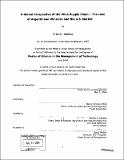| dc.contributor.advisor | Henry Birdseye Weil. | en_US |
| dc.contributor.author | Adamo, Cristian, 1971- | en_US |
| dc.contributor.other | Massachusetts Institute of Technology. Management of Technology Program. | en_US |
| dc.date.accessioned | 2005-06-02T18:58:16Z | |
| dc.date.available | 2005-06-02T18:58:16Z | |
| dc.date.copyright | 2004 | en_US |
| dc.date.issued | 2004 | en_US |
| dc.identifier.uri | http://hdl.handle.net/1721.1/17863 | |
| dc.description | Thesis (S.M.M.O.T.)--Massachusetts Institute of Technology, Sloan School of Management, Management of Technology Program, 2004. | en_US |
| dc.description | Includes bibliographical references (leaves 74-76). | en_US |
| dc.description.abstract | Consumers are constantly demanding better products, at lower prices, along with better overall services and customer support. Organizations, on the other hand, are struggling with shorter product life cycles, increased product variety and lower profit margins due to fierce global competition and faster commoditization of products and services. In a new, global world, targeting local markets does not seem to be enough for long-term company survival. Good supply chain management and design is becoming a key factor for resource optimization, overall user experience enhancement and to achieve a competitive strategic advantage in order to gain sustainable growth ratios. This thesis analyses how current trends in Supply Chain Management are affecting the global wine supply chain, and builds on the specific case of Argentinean wineries that sell their products in the U.S. market. I start by analyzing each tier of the supply chain using Porter's Five Forces model in order to understand the characteristics of each tier, how these forces impact the supply chain as a whole, and how companies interact between tiers. While doing so, I also analyze how current trends in Supply Chain Management are affecting the current state of the supply chain. Finally, I describe possible changes in the supply chain configuration due to the adoption of these new trends by organizations along the chain, and describe some of the major aspects that Argentinean wineries should take into account in order to gain a better competitive advantage along the chain. | en_US |
| dc.description.statementofresponsibility | by Cristian Adamo. | en_US |
| dc.format.extent | 76 leaves | en_US |
| dc.format.extent | 4844860 bytes | |
| dc.format.extent | 4851407 bytes | |
| dc.format.mimetype | application/pdf | |
| dc.format.mimetype | application/pdf | |
| dc.language.iso | eng | en_US |
| dc.publisher | Massachusetts Institute of Technology | en_US |
| dc.rights | M.I.T. theses are protected by copyright. They may be viewed from this source for any purpose, but reproduction or distribution in any format is prohibited without written permission. See provided URL for inquiries about permission. | en_US |
| dc.rights.uri | http://dspace.mit.edu/handle/1721.1/7582 | |
| dc.subject | Management of Technology Program. | en_US |
| dc.title | A global perspective of the wine supply chain : the case of Argentinean wineries and the U.S. market | en_US |
| dc.type | Thesis | en_US |
| dc.description.degree | S.M.M.O.T. | en_US |
| dc.contributor.department | Management of Technology Program. | en_US |
| dc.contributor.department | Sloan School of Management | |
| dc.identifier.oclc | 56607925 | en_US |
